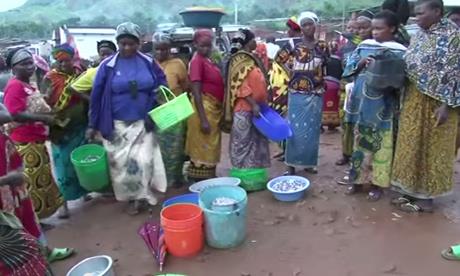Pêcheurs du Monde: women fish-processors of Burundi in spotlight at film festival in France
Over ten years ago, in the village of Mvugo in Burundi, an FAO project set out to improve fish-processing methods with a simple innovation – a system of raised racks for drying fish. Today, the project's impact can be seen across Africa. And this weekend,

© FAO
On the shores of Lake Tanganyika in Burundi, a fish trader named Jeanne Nzisabira stands proudly by her rack of drying fish as she looks directly at the video camera: “I have learned the fish drying technique from fish operators' associations," she says. "I realized that drying fish on racks is more hygienic. I was amazed and decided to sell only raised rack-dried fish.”
Jeanne appears in an FAO video about the project "Support to post-harvest fisheries technology," implemented by FAO and the Burundi Government in 2004. This weekend the video – and the story it tells – will be featured at Pêcheurs du Monde (Fishermen of the World), an international film festival held annually in Lorient, France, that showcases new or recent films about fishermen and women, the fishing industry and the sea.
The story
The video, which will be shown on the last day of the festival, shows how the new method of drying fish using raised racks has enabled women across West Africa to increase income for themselves and their families. The method has been credited with empowering communities as well as improving food security and nutrition.
In the past, the women, who comprise the majority of fish processors, had always dried the catches of small sardine-like silver lake fish (called ndagala) on the ground, where they were easily contaminated, trampled, or eaten by animals. During the rainy season, many fish would be washed away or would start to rot.
Working with Burundi’s Fisheries and Aquaculture Department, FAO started small, constructing just 48 simple wire-mesh racks suspended a metre above the ground. The project distributed leaflets and offered training on how to build the racks, and driers quickly saw the benefits: not only did the racks keep the fish safe from animals, they reduced drying time from three days to just eight hours, meaning they could dry multiple batches of fish in the same day. In addition, the racks could be covered when it rained, preventing runoff and spoilage.
Word spread fast among fishing communities, and the use of racks exploded along the shores of the lake. Since the end of the project, the area dedicated to fish drying near the village of Mvugo has increased from one acre to five acres, and the number of driers at official fishing sites along the shores of Lake Tanganyika has increased from 500 to over 2 000. According to FAO Fishery Industry Officer Yvette Diei-Ouadi, the snowball effect has gone even further: “Even fishing communities in neighbouring countries have taken up the rack-drying technique,” she said.
Women leading the process
Ms Diei-Ouadi, who will be attending the Festival on FAO's behalf, noted the importance of women to the success of the project. “Women were at the center of the process,” she said. “Throughout the implementation they were the ones leading the process of learning and even transferring it to other processors.”
Thanks to the raised racks, the quantity of fish lost or wasted due to inadequate drying practices has more than halved. And the longer shelf-life of the rack-dried ndagala allows for it to be transported not only to inland but also to transborder and regional markets, contributing to the nutrition of communities who live far from sources of fresh fish. Lastly, as the quality of the dried fish has improved, prices have more than doubled, from 4 000 Burundian francs (US$2.5/kg) in 2004 to 9 000 (US$6/kg) in 2013.
To women like Jeanne Nzisabira, such differences count for a lot. Pelousi Ndayisaba, another woman fish dryer who is featured in the video, puts it plainly: “I am able to look after my child because of the business I do trading fish. It is the only activity that provides me with a living.”
|
The Festival Since its inception, the Pêcheurs du Monde International Film Festival has showcased over a hundred films dedicated to fishing and fishers from all over the world. Along with awards, the Festival features debates and discussions between film directors, scientists, members of the fishing world and the public. Festival members this year chose to honor the memory of Chandrika Sharma, a tireless campaigner for the rights of small-scale fishers who was instrumental to the adoption of FAO’s Voluntary Guidelines on Sustainable Small-Scale Fisheries, by naming a prize in her honor. The Prix Chandrika Sharma will be awarded to a film depicting the struggle to recognize gender rights in small-scale fisheries. |
See also:
FAO Video (English): FAO project in Burundi: ''Support to post-harvest fisheries technology'' - Short version
FAO Video (French): Un projet de la FAO au Burundi: ''Appui à la technologie post-capture de poisson'' - Version courte
FAO Fishery Industry Officer Yvette Diei-Ouadi on women's pivotal role across the fish value chain, and in post-harvest processing in particular:
- in English - Women paving the way
- in French - Les femmes ouvrent la voie
